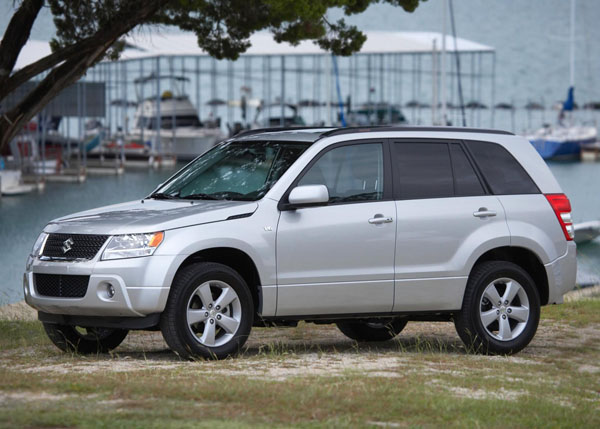
2009 Suzuki Grand Vitara
Unlike many ‘toy’ 4WDs on sale these days the Suzuki Vitara is the real deal. Popular with
those who like to have fun away from the beaten track the Vitara works well on the beach,
on forest trails and even in quite serious off-road conditions.
Though the names ‘Grand Vitara’ and just plain ‘Vitara’ were used in different series most
people simply refer to them all as Vitara. Basically, the Grand title was used on the 2005
but from the model change of 2015, it disappeared again.
When an all-new third generation Suzuki Vitara was introduced in August 2005 it no longer
used a separate chassis, rather it has a monocoque body. However, it was toughened up
with serious strengthening that can almost be described as ladder-frame. Ruggedness has
always been part of the Vitara makeup and owners love them for that.
A virtually all-new model Grand Vitara was launched in 2015. The body has a neat look
with semi-sharp details that look great.
Quite a few were sold with two-tone paint in a time when others were purely mono paint.
This appealed to both the young and old buyers, particularly the latter as they were from
the glory hippie days of the ’70s.
We’ve seen some used examples that have done very little work and are in very good
condition. These are worth hunting down.
The 2015 model was sold with the option of 2WD to keep the price down for those looking
only for an on-road vehicle.
2016 Suzuki Vitara
Vitara is offered in three- and five-door bodies. The five-door is significantly larger than in
previous generations and can make a good family wagon. Competition in the SUV
segment was starting to really warm up by this time, but Vitara aces many of the so-called
4WDs in its makeup.
While it does have four-wheel drive, the three-door doesn’t have a dual-range transfer box
so isn’t suited to really rugged off-road running. All three-doors have a manual gearbox.
With 4WD It is particularly popular as it can be taken to the beach to provide a huge
amount of fun.
Vitara doesn’t handle the way a car does. The Suzuki has a higher centre of gravity so is
easier to roll if you get things wrong. Drive it correctly and it will handle well enough; drive
it too hard and it may bite you. The later the model the safer it is in these circumstances.
Power comes from a variety of sources; four-cylinder 1.6 and 2.0-litre petrol, V6 2.7-litre
petrol and four-cylinder 1.9-litre turbo-diesel. Not all engines are offered in each variant.
Suzuki has been around for a long time in Australia and is well-organised. We have heard
of very few complaints about spare parts and servicing costs.
A good amateur mechanic can do a lot of their own work and underbonnet access is very
good. Safety-related work should only be done by professional mechanics.
Insurance costs seem to vary more than normal from company to company, possibly
because they have had different experiences. It’s worth shopping around. As always,
make sure you understand what coverage you are getting.
2019 Suzuki Vitara
WHAT TO LOOK FOR
Look for damage to the tyres caused by use on severe off-road terrain. Tyres with uneven
wear probably indicate wheel or chassis alignment troubles.
Check for damage caused by off-road driving. The corners of the bumpers and the sill
panels are usually the first to be scratched or dented.
If you find sand in underbody areas, taste it for salt. Corrosion can wreak havoc with rust if
it gets into metal. Search for rust in the lower edges of the doors, the guards, door sills,
cabin and boot floor and in the fuel-filler flap.
Look at the protection plates under the engine and gearbox, as well as suspension mounts
for signs of damage.
Feel for an engine that is reluctant to start and down on power. Look for smoke from the
exhaust pipe and the oil-filler hole.
Make some fast downshifts on a manual gearbox and listen for clashed changes or a
reluctance to change.
In an automatic be sure it shifts quickly into Drive from Neutral and l that the changes are
positive.
Take your hands off the steering wheel while the Vitara is travelling in a straight line and
see if it wanders about unnecessarily. If it does, there could be suspension damage.
HOW MUCH?
Expect to spend from $4000 to $7000 for a 2006 Suzuki Grand Vitara; $6000 to $10,000
for a 2007 Grand Vitara Prestige; $8000 to $10,000 for a 2010 Grand Vitara Prestige;
$10,000 to $12,000 for a 2012 Grand Vitara; $12,000 to $17,000 for a 2014 Grand Vitara
Sports or a 2016 Vitara S; $16,000 to $22,000 for a 2016 Vitara RT-X; $18,000 to $25,000
for a 2017 Vitara S; and $26,000 to $35,000 for a 2021 Vitara Allgrip.
CAR BUYING TIP
These days many 4WDs never leave sealed roads so beware of one that looks as though
it has been thrashed in rough areas.
RECALLS: To browse recalls on all vehicles go to the ACCC at:
www.productsafety.gov.au/products/transport/cars/